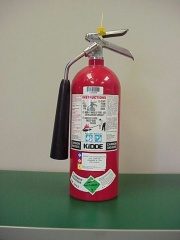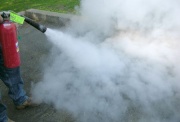Difference between revisions of "Carbon dioxide fire extinguisher"
m (Text replace - "== Authority ==" to "== Sources Checked for Data in Record ==") |
|||
| (2 intermediate revisions by the same user not shown) | |||
| Line 1: | Line 1: | ||
| − | [[File: | + | [[File:image1_carbondioxidefireextinguisher.jpg|thumb|Carbon Dioxide fire extinguisher]] |
| − | |||
| − | |||
== Description == | == Description == | ||
| − | + | [[File:Image3_802518.jpg|thumb|Carbon dioxide fire extinguisher]] | |
A fire extinguishing system that uses noncombustible [[carbon dioxide]] to cover the flammable components; this displaces [[oxygen]] and smothers the flames. A carbon dioxide compressed air system is a nonaqueous fire extinguishing system used in museum storage rooms and electrical areas because it can stop the fire without the use of [[water]]. However, the gas is asphixiating to humans and may leave smoldering areas that can re-ignite when the room is vented. The carbon dioxide hand-carried extinguishers use a foam (snow) or liquid CO2 . The carbon dioxide is heavier than air and is very useful for fighting fires in low places. These extinguishers are used for fires that involve flammable liquids, oils, grease, or electrical equipment. | A fire extinguishing system that uses noncombustible [[carbon dioxide]] to cover the flammable components; this displaces [[oxygen]] and smothers the flames. A carbon dioxide compressed air system is a nonaqueous fire extinguishing system used in museum storage rooms and electrical areas because it can stop the fire without the use of [[water]]. However, the gas is asphixiating to humans and may leave smoldering areas that can re-ignite when the room is vented. The carbon dioxide hand-carried extinguishers use a foam (snow) or liquid CO2 . The carbon dioxide is heavier than air and is very useful for fighting fires in low places. These extinguishers are used for fires that involve flammable liquids, oils, grease, or electrical equipment. | ||
| − | |||
| − | |||
== Synonyms and Related Terms == | == Synonyms and Related Terms == | ||
| Line 12: | Line 8: | ||
CO2 fire extinguisher; CO2-Feuerlöschanlage (Deut.); extincteur à neige carbonique (Fr.); extintor de CO2 (Port.) | CO2 fire extinguisher; CO2-Feuerlöschanlage (Deut.); extincteur à neige carbonique (Fr.); extintor de CO2 (Port.) | ||
| − | == | + | == Risks == |
| − | |||
| − | |||
| − | |||
| − | |||
| − | |||
| − | |||
| − | |||
| − | |||
| + | * Noncombustible. | ||
| − | == | + | ==Resources and Citations== |
* G.S.Brady, ''Materials Handbook'', McGraw-Hill Book Co., New York, 1971 | * G.S.Brady, ''Materials Handbook'', McGraw-Hill Book Co., New York, 1971 | ||
Latest revision as of 15:14, 19 May 2022
Description
A fire extinguishing system that uses noncombustible Carbon dioxide to cover the flammable components; this displaces Oxygen and smothers the flames. A carbon dioxide compressed air system is a nonaqueous fire extinguishing system used in museum storage rooms and electrical areas because it can stop the fire without the use of Water. However, the gas is asphixiating to humans and may leave smoldering areas that can re-ignite when the room is vented. The carbon dioxide hand-carried extinguishers use a foam (snow) or liquid CO2 . The carbon dioxide is heavier than air and is very useful for fighting fires in low places. These extinguishers are used for fires that involve flammable liquids, oils, grease, or electrical equipment.
Synonyms and Related Terms
CO2 fire extinguisher; CO2-Feuerlöschanlage (Deut.); extincteur à neige carbonique (Fr.); extintor de CO2 (Port.)
Risks
- Noncombustible.
Resources and Citations
- G.S.Brady, Materials Handbook, McGraw-Hill Book Co., New York, 1971
- Dictionary of Building Preservation, Ward Bucher, ed., John Wiley & Sons, Inc., New York City, 1996
- Van Nostrand's Scientific Encyclopedia, Douglas M. Considine (ed.), Van Nostrand Reinhold, New York, 1976

